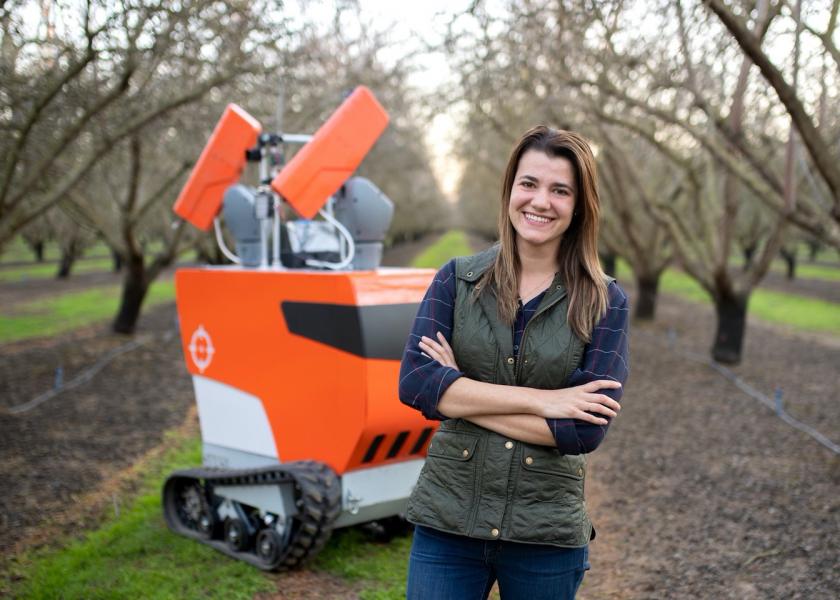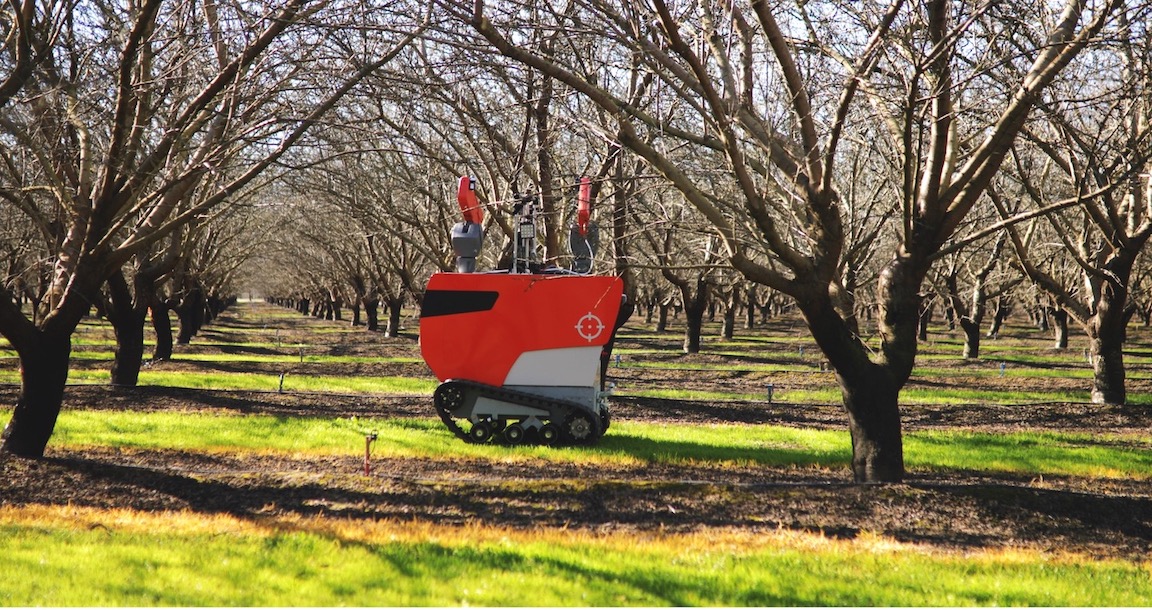Bull’s-Eye Farm Technology: Robot Patrols Almond Orchards, Blasts Mummies

A robot moves through a California almond orchard and casts a digital eye into a limb canopy in search of navel orangeworm prey—larvae hidden within mummy hulls clinging to bare branches. In a symphony of seconds, the rover notes a mummy hull, aims an air-powered turret skyward, and releases a biodegradable pellet. Bull’s-eye. The mummy tumbles to the orchard floor and the rover continues its round-the-clock orchard vigil. Lock, stock, and smoking barrel.
California accounts for a stunning 80% of global almond production. Navel orangeworm (NOW) is insect enemy No. 1, annually inflicting millions of dollars in damage and control costs on the Central Valley’s $6 billion almond kingdom. However, the arrival of a precision, pellet-slinging, automated rover may provide almond growers with a cutting-edge NOW control weapon. Welcome to the debut of InsightTRAC Rover and the age of robotic mummy removal.
NOW Pain
In 2019, Anna Haldewang, a Midwestern inventor hailing from the corn and soybeans of northern Indiana, and founder and chief executive officer of InsightTRAC, set out to tackle the NOW dilemma. “Orangeworm is a major pain point for almond growers,” she says, “and they need a solution that doesn’t rely on weather or hand labor.”
During the Central Valley’s August-to-October harvest, mechanical shakers displace nuts from trees—but not all the almonds fall to the orchard floor. Mummy hulls remain stuck to branches, providing potential overwintering homes for NOW larvae. In spring, moths emerge from the mummy hulls and the cycle begins again with some orchards experiencing up to $300 per acre in damage. Additionally, 58% of rejects at almond processing are related to NOW, according to Haldewang.

During winter, growers typically combat NOW with additional mechanical shaking or labor crews armed with bamboo poles to manually knock down hulls. “Winter sanitation in orchards can be extremely difficult and expensive,” Haldewang describes. “The shakers go back through and shake the bottom of the trunk, but it only works during a heavy fog or after a rain when the mummies are heavy with extra moisture that gives them additional weight to fall. Some growers use hand-polers and that means a high labor cost, and it’s also not easy to source the labor.”
Multipurpose Rover
Haldewang’s invention, the Rover, is approximately 4’ wide, 5’ long, 6’ tall, and propelled on rubberized tracks. Navigating by GPS and equipped with artificial intelligence and an orchard identification camera system, the Rover is zeroed in on mummy recognition. Day or night, it moves down rows, stopping at each tree to check the branches for mummy presence. Once a mummy ID is made, machine-learning maps out the quickest route and angle to the hull within seconds. The robot aims one of two turrets positioned atop its frame into the bare canopy and shoots a single biodegradable pellet at the hull target. (The turrets fire accurately at up to 30-plus feet.) The Rover checks the rest of the branches, repeating the process as needed when other mummies are located, and then moves to the next tree in line.
InsightTRAC’s autonomous Rover operates via electric power providing several days of run-time. The batteries can also be powered in the field by an onboard diesel generator.
EMBED YOUTUBE VIDEO HERE:
“The industry standard is to get down to 2 mummies or less per tree,” Haldewang says. “If, for example, an orchard has 50 mummies per tree, the Rover can clear one acre in a few hours, and that’s 24 hours per day and seven days per week. We estimate it is equivalent to the work of eight polers. A technician needs to be on-site at an orchard, but only nearby. They can be in a truck cab as long as they have eyes on it.”
Beyond NOW removal, the Rover provides extensive data collection, Haldewang emphasizes. “While knocking off mummies, it collects data on the tree, variety, and acre. We then provide a grower with a heat map to show the heaviest and lightest infestation areas, and total of mummies removed. The grower sees the patterns over time and can tie those patterns to other seasonal activities such as water stress or shaking twice in a certain section.”
InsightTRAC will begin delivery of units in fall 2022, and the company currently has pilot programs in California and Australia (home to 6% of global almond production). Beyond almonds, InsightTRAC will extend focus to pistachios and walnuts—both susceptible to NOW infestation.

“From a seasonal perspective, our Rover is going to always stay in the orchard, performing a role for the grower,” Haldewang says. “First, its purpose is to tackle navel orangeworm, but we’re going to shift it to year-round, additional activities to benefit the orchard.”
“Our goal when we started was a robot that would effectively control navel orangeworm and remove weather and labor as factors,” she adds. “The Rover achieves that goal for almond growers.”







